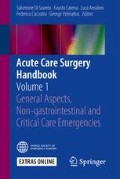Abstract
Emergencies in otorhinolaryngology may be focused on two major issues: acute respiratory distress secondary to the upper respiratory way obstructions and intractable epistaxis.
Access this chapter
Tax calculation will be finalised at checkout
Purchases are for personal use only
References
Epistaxis
Rudmik L, Smith TL. Management of intractable spontaneous epistaxis. Am J Rhinol Allergy. 2012;26(1):55–60. doi:10.2500/ajra.2012.26.3696.
Rossi G. Manuale di otorinolaringoiatria. Torino: Minerva Medica; 1992.
Gicquel P e Fontanel JP. Epistassi. Encycl Méd Chir (Editions Scientifiques et Médicales Elsevier SAS, Paris, tutti i diritti riservati), Otorinolaringoiatria, 20-310-A-10, 2002, 9 p.
Presutti, Le tecniche endoscopiche nel controllo delle epistassi severe, in la chirurgia endoscopica dei seni paranasali e della base cranica, Quaderni Monografici di Aggiornamento A.O.O.I., p. 189–198.
E. Cunsolo, R. Consalici, in L’anatomia vascolare clinica del distretto naso-sinusale, Epistassi, San Felice Circeo, 2006, p. 45–71.
LLee HY, Kim HU, Kim SS, Son EJ, Kim JW, Cho NH, et al. Surgical anatomy of the sphenopalatine artery in lateral nasal wall. Laryngoscope. 2002;112:1813–8.
Melia L, McGarry GW. Epistaxis: update on management. Curr Opin Otolaryngol Head Neck Surg. 2011;19:30–5.
Koh E, et al. Epistaxis, vascular anatomy, origins and endovascular treatment. Am J Roentgenol. 2000;174:845–51.
Leung RM, Smith TL, Rudmik L. Developing a laddered algorithm for the management of intractable epistaxis: a risk analysis. JAMA Otolaryngol Head Neck Surg. 2015;141:405–9. doi:10.1001/jamaoto.2015.106.
Chandler JR, Serrins AJ. Transantral Ligation of the internal maxillary artery for epistaxis. Laryngoscope. 1965;75:1151–9.
Kumar S, Shetty A, Rockey J, Nilssen E. Contemporary surgical management of epistaxis. What is the evidence for sphenopalatine artery ligation ? Clin Otolaryngol. 2003;28:360–3.
Nouraei SA, Maani T, Hajioff D, Saleh HA, Mackay IS. Outcome of endoscopic sphenopalatine artery occlusion for intractable epistaxis: a 10-year experience. Laryngoscope. 2007;117(8):1452–6.
Pletcher SD, Metson R. Endoscopic ligation of the anterior ethmoid artery. Laryngoscope. 2007;117:378–81.
Citardi MJ, et al. Management of carotid artery rupture by monitored endovascular therapeutic occlusion. Laryngoscope. 1995;105:1086–9.
Chen D, et al. Epistaxis originating from traumatic pseudoaneurysm of the internal carotid artery : diagnosis and endovascular therapy. Laryngoscope. 1998;108:326–31.
Celil G, et al. Intractable epistaxis related to cavernous carotid artery pseudoaneurysm: treatment of a case with covered stent. Auris Nasus Larynx. 2004;31:275–8.
Sokoloff J, Wickbom I, McDonald D, et al. Therapeutic percutaneous embolization in intractable epistaxis. Radiology. 1974;111:285–7.
Guss J, Cohen MA, Mirza N. Hard palate necrosis after bilateral internal maxillary artery embolization for epistaxis. Laryngoscope. 2007;117:1683–4.
Willems PW, Farb RI, Agid R. Endovascular treatment of epistaxis. AJNR Am Neuroradiol. 2009;30:1637–45.
Moshaver A, Harris JR, Liu R, et al. Early operative intervention versus conventional treatment in epistaxis: randomized prospective trial. J Otolaryngol. 2004;33:185–8.
Christensen NP, Smith DS, Barnwell SL, et al. Arterial embolization in the management of posterior epistaxis. Otolaryngol Head Neck Surg. 2005;133:748–53.
Miller TR, Stevens ES, Orlandi RR. Economic analysis of the treatment of posterior epistaxis. Am J Rhinol. 2005;19:79–82.
Emergency Tracheotomy
De Leyn P, Bedert L, Delcroix M, Depuydt P, Lauwers G, Sokolov Y, Van Meerhaeghe A, Van Schil P, Belgian Association of Pneumology and Belgian Association of Cardiothoracic Surgery. Tracheotomy: clinical review and guidelines. Eur J Cardiothorac Surg. 2007;32(3):412–21. Epub 2007 Jun 27.
Fois V. La tracheotomia d’urgenza, in le urgenze ed emergenze in orl, Quaderni di aggiornamento A.O.O.I., 2003.
E. Colombo, La tracheotomia: principi e conseguenze sul piano anatomico e funzionale, in le tracheotomie, Quaderni monografici di aggiornamento A.O.O.I., p. 23–30.
Damrose EJ. On the development of idiopathic subglottic stenosis. Med Hypotheses. 2008;71(1):122–5. doi:10.1016/j.mehy.2007.12.017. Epub 2008 Mar 4.
Navsa N, Tossel G, Boon JM. Dimensions of the neonatal cricothyroid membrane – how feasible is a surgical cricothyroidotomy? Paediatr Anaesth. 2005;15(5):402–6.
Goldenberg D, Ari EG, Golz A, Danino J, Netzer A, Joachims HZ. Tracheotomy complications: a retrospective study of 1130 cases. Otolaryngol Head Neck Surg. 2000;123(4):495–500.
Rogers ML, Nickalls RW, Brackenbury ET, Salama FD, Beattie MG, Perks AG. Airway fire during tracheostomy: prevention strategies for surgeons and anaesthetists. Ann R Coll Surg Engl. 2001;83(6):376–80.
Sarper A, Ayten A, Eser I, Ozbudak O, Demircan A. Tracheal stenosis aftertracheostomy or intubation: review with special regard to cause and management. Tex Heart Inst J. 2005;32(2):154–8.
Author information
Authors and Affiliations
Corresponding author
Editor information
Editors and Affiliations
Rights and permissions
Copyright information
© 2017 Springer International Publishing Switzerland
About this chapter
Cite this chapter
Guarino, P., Alicandri-Ciufelli, M., Presutti, L. (2017). Emergencies in Otolaryngology: Head and Neck Surgery. In: Di Saverio, S., Catena, F., Ansaloni, L., Coccolini, F., Velmahos, G. (eds) Acute Care Surgery Handbook. Springer, Cham. https://doi.org/10.1007/978-3-319-15341-4_6
Download citation
DOI: https://doi.org/10.1007/978-3-319-15341-4_6
Published:
Publisher Name: Springer, Cham
Print ISBN: 978-3-319-15340-7
Online ISBN: 978-3-319-15341-4
eBook Packages: MedicineMedicine (R0)

